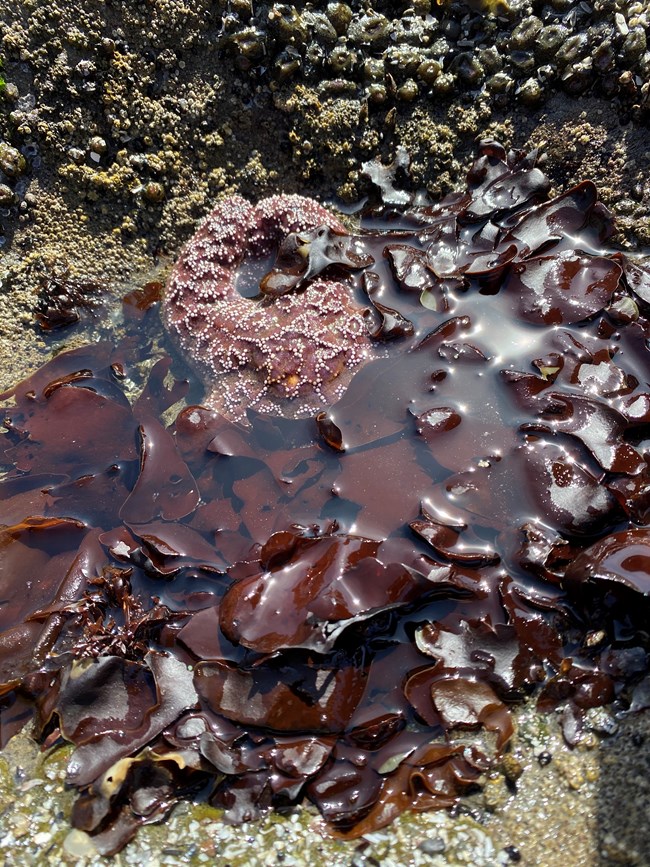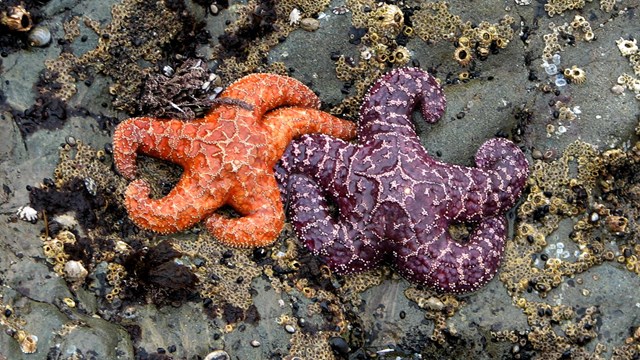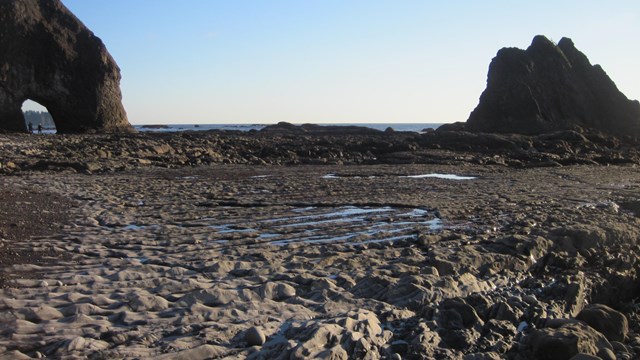
NPS photo The coastline of Olympic National park, shrouded in its mist and mystery, may appear quiet and lonesome. However, at a closer look, the bustling traffic of wildlife is abundant around every turn! Twice each day life thrives and is viewable as the ocean takes a breath and pulls its waves back to reveal the tidepools of Olympic's wild shoreline. Along with climbing the park's high peaks and walking the trails through towering rainforests, tidepooling the beaches is a wonderful way to get a close-up view of some of Olympic's less-known plant and animal residents. What is a Tidepool?As the tide rolls back, the rocky outcroppings beneath the waves are exposed. As this happens, ocean water is caught in basins, alcoves, and crevices within the rock surface. Along with the water comes the plants and animals that make these pools their home and the animals that are washed in and stay until the next high tide comes and washes them out. What is Tidepooling?Walking along the edge of these pools gives visitors a firsthand glimpse into the daily life of the fishes, plants, and invertebrates that are unique to the Pacific shoreline. Before you go, be sure to review proper tidepool etiquette and safety to better protect yourself and the pools, and keep current with the best places and times to tidepool. What Animals Are In There?Just as people live in different areas, so do tidal animals. Some people like a big city, others like the dense forest to surround their homes, and still others prefer the wide open plains. Clinging to the open rock surfaces, swimming in the glistening pools, and even squeezed snugly between nooks and crannies, life is teeming. Many of the animals that make tidepools their home are invertebrates. Along with the small animals of Olympic's tidepools, the waters off the coast of the park provide sanctuary for a variety of marine mammals. Venture to the edge of the pool, peer down, and discover an often hidden world. Where and when to see these diverse creatures all depends upon the time of the low tide and how far down the waves relenquish their grip on the different Tidal Zones.
Tidal Zones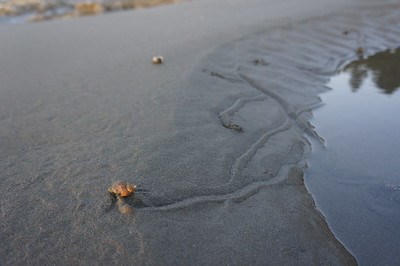
NPS photo Splash ZoneWhere the waves splash up and crash against the sea boulders, the distinct coiled shell of the Common Periwinkle (Littorina littorea), or sea snail, holds tight. The Ribbed Limpet (Lottia digitalis) clutches the rock as they graze on moist algae. Remnants of former Splash Zone residents can be seen in the smooth holes that have been carved out of the rocks. These seemingly endless pockmarks were left behind by the Common Piddock (Penitella penita), a mollusk that bores into the rock for protection from predators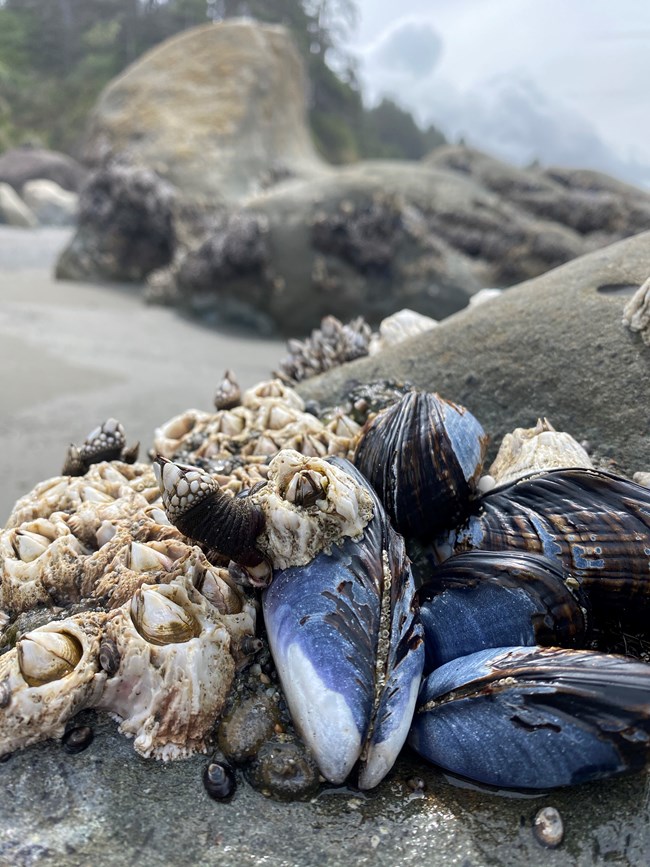
NPS Ranger Margo Roseum High Tide ZoneDuring all low tides, the High Tide Zone is exposed as the waters begin to pull back off of the shore. As you walk along the rocks to get a closer view into the churning waters, be careful not to step on the Acorn (Balanus glandula) and Gooseneck (Pollicipes polymerus) Barnacles. These animals seem glued to the rock in large numbers, hiding away in protective layers of calcium. Another heavily armored creature in this zone is the Blue Mussel (Mytilus torssulus).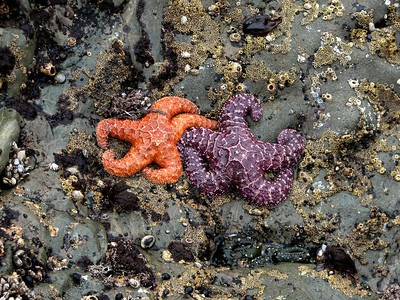
NPS photo Mid Tide ZoneWhere the tidepools are at their most vibrant, Giant Green Anemones (Anthopleura xanthogrammica) and Aggregating Anemones (Anthopleura elegantissima) flash bright green and pink. Amidst the patchwork of color, the distinct oranges, purples, and brick reds of Ochre Seastars (Pisaster ochraceus) and other starfish appear. Buried within the sands and under rocks of the shallow pools, the distinct row of scales of the Cooper's Chiton (Lepidozona cooperi), also known as a Coat-of-Mail shell, can be found. Skittering from pool to pool, the purple-shelled Dungeness Crab (Cancer magister) and hermit crabs can sometimes be seen scavenging amongst dense sea grasses. Even those that prefer deeper waters, like octopus and fish species, can occasionally find themselves as temporary residents of the many tidepools until the water rises once more.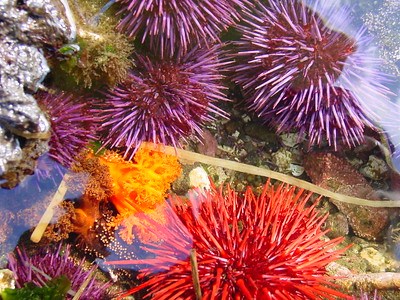
NPS photo Low Tide Zone
When the water is at its lowest, during a new or full moon, the Low Tide Zone appears. Seldom seen life is finally active and viewable, such as a variety of spiky Sea Urchins and vibrantly colored Nudibranch.
|
Last updated: November 8, 2024

